Mystic Faerie Tarot Deck Review
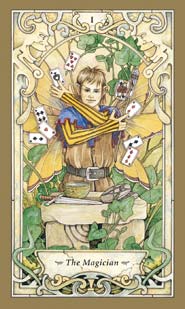
Creators: Barbara Moore, Linda Ravenscroft
Published: 2007
The Mystic Faerie Tarot is an enchanting faerie tarot painted in watercolours by fantasy artist Linda Ravenscroft. Ornate borders and gold edges surround tarot images of sprites, nymphs, mermaids and faeries, in a charming, pretty and readable new tarot deck.
Card Images from the Mystic Faerie Tarot

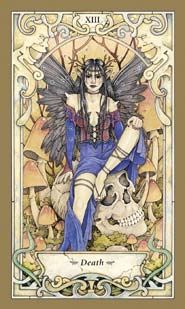
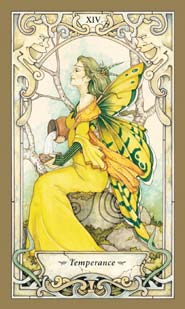
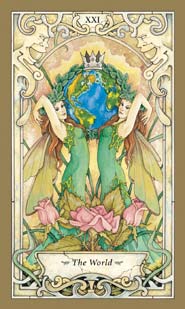
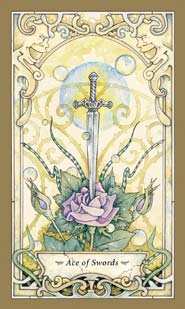
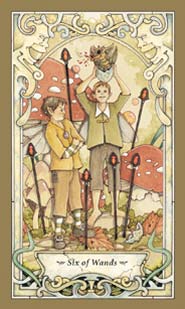
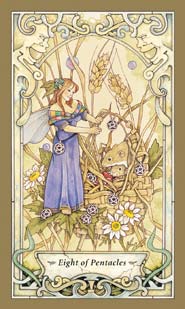
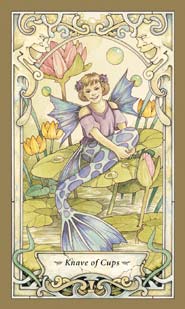
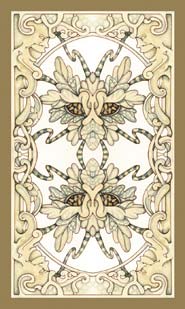
Mystic Faerie Tarot Sample Images - art by Linda Ravenscroft, text by Barbara Moore © 2007 Llewellyn Worldwide, 2143 Wooddale Drive, Woodbury, MN 55125-2989. All rights reserved, used by permission.
Retailers
See Price at Amazon.comSee Price at Amazon.co.uk
See Price at Amazon.ca
Mystic Faerie Tarot Review by Kim Huggens
Here in Britain, this summer is set to be the hottest ever on record. In my mind, this equates to a barbeque every day, ice cold lemonade on English lawns, beautiful gardens in bloom, dancing on Midsummer’s Eve, and other such quaint, charming, and utterly fluffy pastimes. Now, when somebody says the word “fluffy”, it’s usually not intended in a positive way, but this time it truly is.
Oh Gods, I never thought I’d say this… Even though I like my deities like I like my coffee (dark and bitter…) and even though I usually like my Tarot decks laden with enough occult symbolism to raise my long-dead nan from the cold grave and teach her how to dance, every now and then… just every one in a while… I want something “fluffy”. I want giggles, and prettiness, and dance, and flowers, and faeries.
Maybe Llewellyn have heard of my dire need for this, since this July sees them beginning a wonderful Summer publishing season with the Mystic Faerie Tarot by British artist Linda Ravenscroft (whose artwork you may already have seen showcased on the front cover of Pentacle magazine or in Pagan Dawn magazine.) And yes, the faeries in this deck are little Victorian-esque flower faeries with beautiful dresses and beautiful hair and faces, in beautiful gardens, with a tiny bit of extra Goth and Pagan thrown into the mix.
And the result is… well… charming. But also effective. And here’s why. (Other than that the artist is British. Yay for patriotism!)
For starters, the deck comes packaged beautifully in a box, accompanied by a lovely golden organza Tarot bag, golden cardboard box for storage, and 312-page book written by renowned Tarot expert Barbara Moore. The gold and pale green colouring of the packaging seems very attractive to me, conjuring up images of peaceful gardens and quiet nature.
The deck itself is great for beginners. The images are simple, refreshingly free from occult symbolism, yet somehow still deeply symbolic. In most places, Ravenscroft has tried to break free of the Rider Waite imagery that often governs the imagination of deck creators, and thus her card images are unique and different. This factor should give even the more advanced Tarot readers food for thought, and a way of breaking out of learned habits with Tarot meanings. Where other decks make it obvious what is a symbol and what isn’t, the Mystic Faerie Tarot has symbolism that blends subtly into the natural environment of the cards. Thus, a simple bubble in the Fool card conveys an important message:
“The Fool fae plays with bubbles, delicate orbs that may burst at the wrong touch. While he can toss them about with no fear of destroying them, for us humans, they represent a brief moment of wondrous choices. We are at a place where many things, maybe all things are possible. The bubbles float lightly on the wind and may, at any moment, go off in an unexpected direction.” ~ p. 12 “A Guide to the Mystic Faerie Tarot”
At first some of the images of the Major Arcana seemed to bed the question a little, such as the Wheel of Fortune, which is just a cute faerie sitting mischievously upon the usual image of the wheel of fortune, or Death which is a quite Goth faerie sitting upon a skull. But I was too quick to dismiss, in this case, since a read through of the book made me realize that although the symbolism isn’t obvious, it is there. In particular flower symbolism, which I found delightful and unusual in a Tarot deck – adding to the deck’s “Cottingly Fairies” feel.
Throughout the deck, there is a slight Pagan feel – with cards such as the Emperor showing a man wearing horns, and the High Priest wearing the mask of the Green Man. The artwork in all the cards is also in an almost-Art Nouveau style, especially with the beautiful borders. And all the Majors are stunning – I’m particularly fond of The Magician. He’s a real trickster, and almost jumps to life in the card.
However, it’s the Minor Arcana that really make this deck for me. In many decks you feel like the artist has copped out on the Minors, which is a shame considering they make up the majority of the pack. But Ravenscroft has done something absolutely spectacular with the four suits: she’s told a fairy story with each one! Starting with the Ace and ending with the Ten, she tells a story that deals with the themes and associations of each suit. The Wands suit’s tale is “The Grand Adventure”, and tells the story of two young fae who take a risky venture together and end up dealing with burden, responsibility, conflict, and duty. The Cups suit is “The Magic Celandine”, a heart warming tale of a nymph and a wood elf who find love in the most unlikely of places. The suit of Swords is given to us as “The Blue Rose”, wherein two fae and their Faery Queen endeavour to save their land from desolation. Finally, the Pentacles suit is “A Faerie’s Fortune”, where a fae learns the value of heard work and dedication one particularly harsh winter.
These tales, told in the book by Barbara Moore, really bring the Minor Arcana to life, and demonstrate the meanings of the cards without lecturing or being boring. Any newcomer to Tarot using this deck is unlikely to have any problems interpreting the Minors, since they can simply recall what part of the story each card represents. This way of portraying the Minors also emphasizes the fact that these cards aren’t usually seen as standalone but as processes and journeys, and it enables any reader – no matter their experience – to quickly link the cards in a reading together (which is an invaluable Tarot skill, in my opinion.)
The book is also wonderful, easy to read, and helpful. It really helps bring the beautiful cards to life, and contains some useful information for both beginners and advanced readers, including some unique Tarot spreads based on the faery world. My personal favourite is the Faerie Ring spread, which is accurate and fun.
At a basic level, this deck sticks to the traditional Rider Waite Smith structure and meanings, including Strength as VIII and Justice as XI. Its’ backs are reversible (with a cool green man motif on them), and every card bears a small title on it.
But the Mystic Faerie Tarot is so much more than that. It is whimsical yet powerful, charming yet truthful, simple yet deeply symbolic and meaningful. The artwork is brilliant, and the deck would be great for first-time readers, children, or those slightly nervous of Tarot. It also shakes the advanced reader from their bad habits and allows them to explore something a little different, just be taking a stroll through the summerlit faerie garden…
Mystic Faerie Tarot Review by Bonnie Cehovet
Faerie Greeting
Faeries clever,
Faeries bright,
From garden,
Wood, and pond,
Guide my thoughts,
Guide my sight.
Please help me
Find the answers
On a path
That's true and right.
~ Linda Ravenscroft
This review will cover the deck only, as the companion book, A Guide To Mystic Faerie Tarot, by Barbara Moore, was received as an uncorrected proof, sans cards, and has already been reviewed. The kit contains the 288 page book, the 78 card deck (with two extra cards, containing a Faerie Greeting and a Faerie farewell), and a yellow bag to house the cards.
The artwork on the front and back of the book (and box) is done in greens, yellow's, and purples, showing the Faerie people at their finest. The cards themselves are 2 3/4" by 4 1/2", of good quality, glossy card stock.
The backs of the cards carry a 1/4" dark gold border, with a fine inner border of lighter gold, surrounding a pattern of gold over a white background. It would not be possible to tell whether the cards had been drawn in the upright or reversed position. The card face carries the same dark gold border, followed by a finer border of lighter gold. Across the top of the card, and in the upper right and left hand corners the pattern is repeated from the back of the cards. At the bottom of the cards is a scroll-like image, with a box over it containing the card title. The Major Arcana carry the card title on the bottom, with the card number, in Roman numerals, on top of the card. The Minor Arcana Pips show the suit name and number, in text, at the bottom of the card. The Court Cards show the title and suit at the bottom of the card.
The Major Arcana follow traditional titles, with the following exceptions:
The High Priestess = Priestess, The Hierophant = Priest, The Hanged Man = The Hanged Fae
The Suits are Wands, Cups, Swords, and Pentacles. The Court Cards are Knave, Knight, Queen, and King. Each of the suits follows its own storyline, offering insights into everyday life issues. The storyline of Wands is a tale of two faeries who set off to seek their fortune. The suit of Cups tells the story of an enduring love between a water nymph and a wood elf. The suits of Cups is represented by the magickal Celandine blooms. Swords are represented by the thorns on roses. The storyline here is that of two young fae, of their resourcefulness, and of their Queen's valiant efforts to save her people. Pentacles are represented by Pentacles, and carry the story of an industrious faerie whose hard work takes an unexpected turn, and of how taking advantage of an unexpected opportunity turns out to be beneficial for everyone involved. The "moral" of the story is reviewed at the end of each storyline.
The coloring used in this deck tends to the pastels, and the artwork is definitely faerie inspired! The Knave of Pentacles shows a young fae seated amongst an abundant crop, enjoying the literal fruit of Mother Nature. Justice shows a blindfolded fae, seated, with a set of scales held in her right hand and an upright sword in her left and. The Hermit sits in the middle of a field of mushrooms, holding his lamp aloft in both hands.
The Eight of Pentacles shows a young fae weaving a basket, while curious (and adorable!) mice look on. She is teaching them to do the weaving. Judgment sits on a leaf, clothed in a white dress, amongst lilies, blowing the trumpet of judgment.
I found this deck easy (and fun!) to work with, and find it a good option to offer as a reading deck for in person readings. It also would have a great deal to offer comparative readings, as well as journaling and meditation.
Faerie Farewell
Faeries clever,
Faeries bright,
From Garden,
Wood, and pond,
You shed your Glorious light.
Many thanks For helping me
Find a path
That's true and right.
~ Linda Ravenscroft
© Bonnie Cehovet
Mystic Faerie Tarot Review by Erica Heath
I am not the sort of person who usually likes the lighter Tarot decks on the market (lighter in mood or in color); I am also not the sort of person who ever buys a Tarot deck without having researched it and read thoroughly its reviews on aeclectic.net. However, I bought this deck and book set (along with one other, Antonella Castelli's Tarot Art Nouveau, which I also plan to review) on total impulse (before I realized it was a full moon!) and I could not be happier with my purchase.
First let me say that the colors on my printed set are richer by far than the washed-out colors I see in the scans on this site. Don't get me wrong, the art is watercolor after all, but the scans to me look to be overexposed, and the card art is stunningly beautiful. The borders are gold ink, which I thought was a really nice touch.
The box seems pretty solid for a folded paper tarot box, but I don't know yet how it will hold up over time. The gold organza bag for the cards is lovely and the perfect size--not so small you can't properly draw it closed or easily get the cards in and out; not so big the cards shuffle themselves around or get bent in it. The size of the book was a very nice surprise--I hate having to flip through the tiny booklets that come with most decks, and they're a pain to keep open when you're trying to read them. The Mystic Faerie Tarot companion book is the same size as the big box the whole set comes in, I would guess (but haven't measured) about 8x5 inches. It's a sturdy paperback with a nice, shiny, color-printed cover, and the text inside does not require a magnifying glass to read. Each card is printed at fully size or nearly full size before its accompanying text in the book, but they are all in black and white.
This purchase was a bit of a leap of faith for me, because (like I said) I hadn't heard of the deck, read reviews, or researched it at all, and the pictures on the box only showed major arcana cards, so I was a little afraid that the minors might not be fully illustrated. It felt right, however, so I bought the set, and was beyond pleased to find that not only are the minors fully illustrated with scenes, they might be my favorite thing this set has to offer. Let me explain.
Each suit of the minor arcana is designed around a faerie tale specific to that suit. The suit of Wands (represented by actual wands) tells a tale of enterprise, two faeries who embark on an adventure in search of a phoenix; the suit of swords (represented by rose thorns) tells a story of a magical blue rose and the faeries who care for it; the suit of cups (represented by water lily flowers) follows a nymph and an elf (two fae of different races) through their trying romance; and the suit of pentacles (represented by actual pentacles) follows a fae woman who, unable to find her village after getting lost in the forest, starts over on her own and is befriended by mice. The four stories do not all have strictly happy endings, which I did not expect from a faerie deck, but they do all have pretty much universally applicable morals, and they can be applied to the world of humans realistically. Sometimes it seems as if the meaning of a minor lines up with the Rider-Waite meaning of that minor, but I do not think this is the case across the board.
What this faerie tale layout means for the minors is that, because they are essentially illustrations to a story, they will be pretty difficult to read if you have not read (or do not remember) the faerie tales; happily, the stories are short, sweet, and easy to read. What I'm saying is you SHOULD read this companion book cover to cover, and you should do so before trying to read with the cards, which is not something I recommend with most companion books (or booklets, rather).
The concept of the deck as a whole, and the artist & author's stated reason for creating a faerie tarot deck is roughly this: the fae are in perfect balance with nature, which is (or should be) our goal as humans; but we are humans, not fae, and that is not something we can ever completely achieve. However, the fae can teach us what the ideal is, and how we as humans can come closer to achieving that, how we can live in better (if not perfect) balance with nature. This concept is incredibly well executed.
As the daughter of a doctor and a scientist, I have days where I begin to feel skeptical even about the Tarot (these days are rare and this always goes away, but still, they do come). It speaks to the quality of the concept and execution of this deck and book set that not once in my reading of the book or the cards did I feel the least bit silly taking and giving advice from faeries.
Now for the majors. The majors are also beautifully illustrated in rich watercolor and exquisite detail. There is a Priestess instead of a High Priestess, a Priest instead of a Hierophant, and The Hanged Fae instead of The Hanged Man. The meanings in this deck are slightly different than traditional Rider-Waite, so DO read the book first, but they make an immense amount of sense and will be easy to remember. My favorite cards from the majors in this deck are Strength (numbered 8, not 11), the Tower, The Moon & The Sun, and Judgement. This deck's Strength rides a dragon, which is related to the dragon in the story for the suit of wands. In this Tower, the structure is being taken over by nature in ALL directions, and the book offers one of the best explanations for the Tower I have ever read. The Moon & Sun have a beautiful parallel structure (both are represented by women fae whose hair becomes the orb they represent, and the book offers a beautiful explanation for this parallel structure that may change the way I read with other decks. The same sort of parallel structure thing happens with Priestess and Priest, and it is also really well done). I feel that the Judgement card in this deck is particularly strong because of the description offered with it in the book--judgement is a card that has always been difficult for me to relate to on a personal (rather than a bare mathematical understanding of the meaning), but this book makes it easy. This is the case for the whole deck--the cards are stunningly beautiful, and the book makes them ten times better by fulfilling your other four or five senses so that the meanings are forever linked in your imagination and memory. The slight twists on traditional card meanings which make them more appropriate to the world of the fae make them, I think, more relatable to me as well.
The court cards use Knave instead of Page, so you have: Knave, Knight, Queen, King. These run very true to traditional tarot meanings with each suit governing a particular part of human experience, and each rank possessing a certain level of maturity and experience in that realm.
The introduction to the book provides a really good basic understanding of Tarot and even introduces a few things that were good for me to hear again. At the end of the book are included a few original spreads, and I am especially interested to try Acorn to Oak (designed to show the best way to accomplish a goal) and the Birthday Sunflower Spread (meant to be read yearly and provide a general overview).
Overall, I highly recommend this deck
for children and tarot beginners (the symbolism is
easy to understand and really well explained in the
accompanying stories and descriptions, and the stories will
make learning the tarot easier and more fun) as well as
for more experienced readers looking for a refreshing
new perspective on tarot.
Complete Details of Mystic Faerie Tarot
Creators: Barbara Moore, Linda RavenscroftPublisher: Llewellyn 2007
Deck Type: Tarot Deck
Cards: 78
Major Arcana: 22
Minor Arcana: 56
Deck Tradition: Rider-Waite-Smith
Minor Arcana Style: RWS-Based Scenes
Suits: Cups, Swords, Wands, Pentacles
Court Cards: Knave, Knight, Queen, King
The Fool is 0
Strength is 8
Justice is 11
Card Size: 2.75 x 4.63 in. = 6.99cm x 11.75cm
Card Language: English
Card Back: Reversible
Back Design: Knotwork-type design in muted colours
Companion Material: 312-page companion book, written by Barbara Moore, and two extra cards with a Faerie Greeting and Faerie Farewell.
Rating: 18/20 or
Similar Decks to Mystic Faerie Tarot
Theme: FairyCategory: Available Tarot Decks
Creator: Book of Shadows Tarot, Book of Shadows Tarot: Volume 2, Cats Inspirational Oracle, Color Your Tarot, Llewellyn's Classic Tarot, Silver Witchcraft Tarot, Steampunk Tarot, Tarot in Wonderland, Tarot Made Easy, Tarot of the Hidden Realm, Vampire Tarot of the Eternal Night, Wizards Tarot by Barbara Moore
< Previous Deck · Back to Top · Next Deck >
Home > Tarot Reviews > Mystic Faerie Tarot Review

